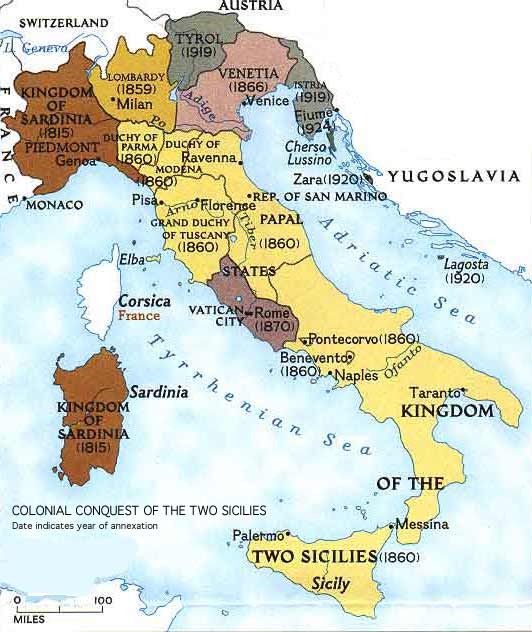WITH HISTORICAL MAPS OF THE TWO SICILIES
CU ‘E MMAPPE STORICHE D’‘E DDOJE SICILIE
CON LOS MAPAS HISTORICOS DE LAS DOS SICILIAS
CON LA CARTOGRAFIA STORICA DELLE DUE SICILIE
 Pre-Norman southern Italy - Around 980 A.D. southern Italy was still partially included in the Byzantine Empire (Yellow area), i.e., Apulia (excluded its northernmost part), and Eastern Basilicata (then known as Lucania), constituting the "Theme of Longobardia" centered at Bari, and Calabria, together with, nominally, the Duchy of Naples (in red), and the Duchy (formerly Republic) of Amalfi (in green), the latter had at first depended on Naples, but at this time is independent. Sicily, Byzantine until the beginning of the Ninth Century is now part of the North African Fatimid Caliphate (Pink areas). In this period cotton, sugar cane, orange and lemon plants were introduced in the island. Palermo became the center of a rich, cosmopolitan, civilization. The Arabs also had secured Bari for some years in the second half of the Ninth Century. Lombard southern Italy was divided in three political entities, the Principality of Salerno (in blue), that of Capua-Benevento (in creamson), and the Duchy of Spoleto (in orange). Economically the Tenth Century was a period of relative stability and growth. Agriculture flourished. Many areas were subjected to Arab raids, however. Amalfi and Naples at times formed alliances with the Arabs. The Patrimony of St. Peter included the Donation of Pepin (756 A.D.), which, added to that of Constantine, put the foundation for what later will become the Papal States (which will survive until 1870), whose territories were originally Byzantine. A good book treating this period is Barbara M. Kreutz's "Before the Normans - Southern Italy in the Ninth and Tenth Centuries. University of Pennsylvania Press (1991)". Pre-Norman southern Italy - Around 980 A.D. southern Italy was still partially included in the Byzantine Empire (Yellow area), i.e., Apulia (excluded its northernmost part), and Eastern Basilicata (then known as Lucania), constituting the "Theme of Longobardia" centered at Bari, and Calabria, together with, nominally, the Duchy of Naples (in red), and the Duchy (formerly Republic) of Amalfi (in green), the latter had at first depended on Naples, but at this time is independent. Sicily, Byzantine until the beginning of the Ninth Century is now part of the North African Fatimid Caliphate (Pink areas). In this period cotton, sugar cane, orange and lemon plants were introduced in the island. Palermo became the center of a rich, cosmopolitan, civilization. The Arabs also had secured Bari for some years in the second half of the Ninth Century. Lombard southern Italy was divided in three political entities, the Principality of Salerno (in blue), that of Capua-Benevento (in creamson), and the Duchy of Spoleto (in orange). Economically the Tenth Century was a period of relative stability and growth. Agriculture flourished. Many areas were subjected to Arab raids, however. Amalfi and Naples at times formed alliances with the Arabs. The Patrimony of St. Peter included the Donation of Pepin (756 A.D.), which, added to that of Constantine, put the foundation for what later will become the Papal States (which will survive until 1870), whose territories were originally Byzantine. A good book treating this period is Barbara M. Kreutz's "Before the Normans - Southern Italy in the Ninth and Tenth Centuries. University of Pennsylvania Press (1991)".
|



